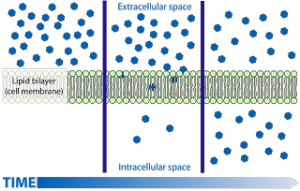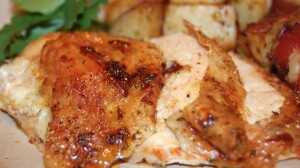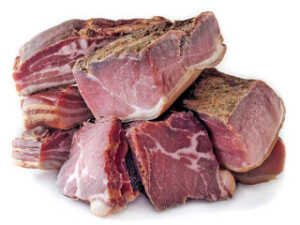Brine is a solution of salt in water, which in charcuterie is intended to preserve, intensify flavor and change the moisture of food, especially meat. It is much faster than dry curing and loads the product with great moisture and flavors from seasonings added to the base brine. There are two aspects here that explain the process of migration of salt and water to the meat, the first relates the osmosis as being the main responsible for the migration of water and salt into the protein, the other side claims that the molecular diffusion is responsible for this migration.
I believe that both chemical phenomena participate in the process, as one does not eliminate the other and both have justified theoretical bases. There is no need to discuss which is the main one, but rather to understand them at a minimum in order to understand the chemical principles that will transform the food, whether for personal consumption or commercialization.
Why does brine make meat juicier?
Dissolving sodium chloride (table salt) in water releases chlorine (Cl-) and sodium (Na+) ions, which penetrate the protein molecules. The chlorine ions accumulated in the protein cause muscle fibers to expand, making room for the accumulation of water. The accumulation of sodium is what brings the salty taste. Therefore, the deeper the brine penetrates the meat, the juicier it will be.
Part of this liquid gain is lost during cooking, but as the meat is more swollen at the beginning of cooking, it ends up juicier than it would be without this gain promoted by the brine. We can check that the meat absorbs the liquid by weighing it before and after brining. They typically weigh six to eight percent more than they did before brining.
If salt dries out meat, how does brine make it juicier?
While low salt concentrations cause the protein to expand, salt concentrations above 6% cause the opposite effect, retracting these fibers and expelling liquids from their interior, keeping it dry and free of microorganisms. However, if the meat is desalted and has its salt concentration reduced to levels below 6%, the potential for liquid retention will be increased again. Our palate usually appreciates salt concentrations between 0.5% and 2% of the total weight of the meat, depending on individual taste. Have you ever tried eating jerky without going through the salt removal process? Don't even try, it will be horrible for both your taste buds and your health.
How does brining preserve meat?
It is known that water is one of the basic ingredients for the proliferation of bacteria, so how can a brine help preserve food? Microorganisms, which cause food to rot and produce toxins that affect our health, do not survive in an environment of high osmotic pressure, that is, one that steals water from them through osmosis. Consequently, the higher the salt concentration, the more the product will be protected. Once again, there is no point in the debate about diffusion or osmosis, because regardless of the process responsible for incorporating salt and water into the meat, the brine will always have osmotic pressure that will affect microorganisms. Brining will not protect the food like a dry salt cure (which expels water from the food by contracting proteins), but it will considerably extend its shelf life by leaving the environment a little more hostile than completely unsalted meat.
Understanding how brine works is essential to apply it correctly. It is not enough to throw food into salt water without taking into account the time needed for the chemical processes to occur as expected. The amount of salt, size of the food and curing time are essential. As the action of brine is very fast, it can easily be excessively salty food.








Hello! My question is approximately how much, on average, do raw meats absorb salt (NaCl) in a wet curing marinade? What if it is a dry cure with just salt and herbs within 2 days of refrigerating seasoning?
It will absorb until it balances the meat concentration of water and meat. The time varies depending on the concentration of salt in the water and the thickness of the meat. Thin meats absorb quickly, thick meats take longer. The ideal is to make the brine by balance: Brine for balance
I'm starting my bacon production, I wanted to know what equipment is needed
For the bacon you will need a smoking environment. It can be a traditional smoker, a pit smoker or a barbecue that you can adapt. If you want to use liquid smoke, just an oven is enough, as you will only need heat, no smoke. You need to decide whether you are going to smoke by burning wood or using liquid smoke.
Hello goodnight.
Can I make the brine for the ham? Do I just leave it in the brine for 12 hours and then add seasoning and leave it for another 5 hours?
Leave for days. Chilled, with your favorite seasonings (but don't forget mustard). Be sure to add sugar to the brine.
I have a question about making a brine for 20 chickens?
For large quantities, the most viable option is to salt the chickens by injection.
Hello, please, after the turkey has been in the brine for 24 hours, does it need to be washed and seasoned before roasting?
Hi Luciana, if the brine has already been made with all the condiments then you don't need any more seasonings, otherwise you can add any other condiments you want. Washing is never necessary.
How to make jerky. How to do the injection? What should I put in the brine to make the jerky turn red: Do I have to add pure salt after the injection???
Hello good morning, is it possible to season bacon in brine in large quantities?
In large quantities, I believe that the most recommended option is to inject the ingredients and leave them refrigerated for 1 or 2 days before cooking/smoking.
Hello, for the brine I can replace the water with other liquids like beer, wine or cachaça. Could this pose any health risk?
Hi, you can replace it with an alcoholic drink, no problem.
Good afternoon, as it is recommended to use 50 g of salt per liter of water; how many liters of water per kg. of meat?
Good morning! I would like to know how brine is made to remove fungus from meat
Sarah, rub a cloth soaked in brine (20g salt/200ml water) to remove unwanted contamination. Dry well and return for maturation. If you have a starter culture (or yakult), spray it on the products to protect it from unwanted microorganisms. Additionally, you can add a tablespoon of vinegar to this brine.
Goodnight!!!
I would like to make the dried meat used in feijoadas, my question is:
I immerse in water, salt, sugar, what are the quantities per kilo for how many days? and After that I put the meat to dehydrate in salt in what proportion and for how long??
I don't know the correct process for jerky, but I believe there is no brine, just salting. Concentrations of 5% of salt dehydrate the meat, so I suggest you add at least 5% (of the volume of the meat) of dry table salt and 2.5g of curing salt per kg of meat and let it dehydrate and cure for about 3 days in the fridge . After this period, you can leave it exposed to the sun for a few more days if you want. But like I said, I don’t know the “official” process.
Hello good afternoon
I have a simple question
When we talk about 4% brine for fish (process before smoking), is 4% of fine salt proportional to the weight of the meat?
10 kilos of fish 400 GR of salt?
It's probably in relation to the amount of water, you just have to get the timing right. If it is a thin fillet or a thick steak, the soaking times will vary.
I would put it in relation to the amount of water heheeheh
That’s why you work for years in the laboratory 🙂
Kandrus, you are right, the correct thing is in relation to the amount of water. I will edit and correct the answer to Francis. Thanks!
I'm setting up a gallery + chickens and I already have a barbecue. However, I would like an opinion other than his. I have to do it, season about 100 chickens to roast or put on the grill on a Saturday, for example. How should I do the process… one by one or is there a way to do the brine process for these larger quantities?
Thank you in advance, hugs
Marcelo
In my opinion, the most practical option is to inject the brine one by one or use an injector and tumbler to speed up the process. Soaking brine is slower and requires a lot of space for that amount.
Eduardo, what would tumbler be? I couldn't even find anything on Google about it. Thank you very much. Roberto
Tumbler is a rotating drum used in industry to marinate, distribute ingredients and massage meat. Reminds you of how cement mixers work.
It's a pork leg concrete mixer... eheheheheh
How do I make corned beef in 3 to 4 hours in brine,
Good evening Eduardo, I would like to know if I can add sodium chloride to the brine for the jerky, how much % for each kilo of meat, thanks in advance! Arnaldo Silva
Arnaldo, for beef jerky, the large-scale production method that I know is as follows: Weigh the meat: Water: measure the same weight as the meat Refined salt: 23% of the weight of the meat Curing salt: 1% of the weight of the meat Make the brine and fillet the meat into 3 to 4 cm. Then immerse the meat in the brine and massage it every hour for 12 hours. After 12 hours, drain and stack on a platform that allows the water to drain at the bottom. Coarse salt is thrown between the blankets and piles of meat 1 to 1.5 meters high are placed. The listings are carried out over 5 days. The “tumble” is to turn the pile over, putting those at the top down and those at the bottom up. After 5 drops, wash it to remove the salt and place it on a wooden clothesline to dry in the sun for 2 days. After that, it's ready to cut and pack. For home production, I only make it with salt. basically I use a lot of salt in the dish, I lay the files on the bed of salt and cover everything (top and sides) with salt and leave it uncovered for a night in the fridge. in day… Read more "
Hi Alexandre, adding curing salt to beef jerky is prohibited and constitutes fraud. What is allowed to use curing salt is jerked.
Thank you Alexandre Erich Klemm, valuable information, it helped a lot!